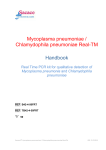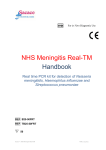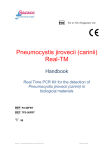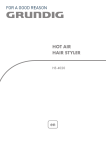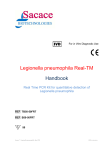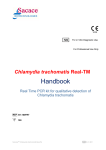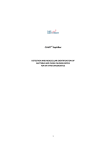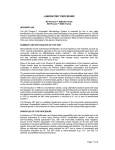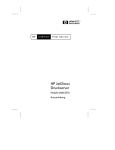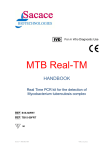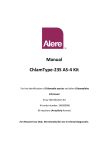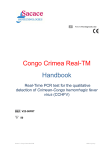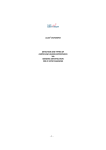Download Listeria Real TM Quant ENG PCR NEW ver 210613 - bio
Transcript
Listeria monocytogenes Real-TM Quant Handbook Real Time PCR Kit for quantitative detection of Listeria monocytogenes REF B14-100FRT 100 Sacace™ Listeria momocytogenes Real-TM Quant VER 21.06.2013 NAME Listeria monocytogenes Real-TM Quant INTRODUCTION Listeria is a genus of bacteria that contains ten species. Named after the English pioneer of sterile surgery Joseph Lister, the genus received its current name in 1940. Listeria species are Gram-positive bacilli. The major human pathogen in the Listeria genus is L. monocytogenes. It is usually the causative agent of the bacterial disease, listeriosis, a serious infection caused by eating food contaminated with the bacteria. The disease affects primarily pregnant women, newborns, adults with weakened immune systems, and the elderly. INTENDED USE Listeria monocytogenes Real-TM Quant kit is a Real-Time test for the Qualitative and Quantitative detection of Listeria monocytogenes. PRINCIPLE OF ASSAY Listeria monocytogenes Real-TM Quant kit is a Real-Time test for the Qualitative and Quantitative detection of Listeria monocytogenes in the biological materials (DNA samples taken from peripheral and umbilical cord blood, cerebro-spinal fluid, node aspirates, nasopharyngeal swabs, the discharge of the eye conjunctiva, amniotic fluid, placenta, the swabs of epithelial cells taken from vagina, urine, breast milk, meconium, feces, autopsy material. The DNA extraction is carried out with the internal control sample (IC) which helps control the test procedure for each sample. During the extraction of DNA from the biological (peripheral and umbilical cord blood, cerebro-spinal fluid, node aspirates, naso-pharyngeal swabs, the discharge of the eye conjunctiva, amniotic fluid, placenta, the scrapes of epithelial cells taken from vagina side parietes, urine, breast milk, meconium, feces) and autopsy material the amplification of the human genome DNA takes place (endogenous internal control). Endogenous internal control (IC Glob) gives the opportunity not only to control the stages of PCR analysis (the DNA extraction and carrying out of PCR), but to evaluate the adequacy of the sampling and the storage of the material as well. Then the amplification of L.monocytogenes DNA is carried out using the specific for the DNA primers and Taq-polymerase enzyme. The reaction mix contains fluorescently labeled oligonucleotide probes which hybridize with the complementary area of the amplified DNA-target, as the result the fluorescence intensity grows. The fluorescence signal detection is carried out using the thermo cycler with the system of fluorescence signal detection in real-time mode. Listeria monocytogenes DNA amplification is detected on JOE(Yellow)/HEX/Cy3 channel, the IC DNA amplification is detected on FAM (Green) channel, the signal of the β-globin gene (IC Glob) amplification product is detected on ROX(Orange) channel. Sacace™ Listeria momocytogenes Real-TM Quant VER 21.06.2013 Quantitative DNA analysis is based on the linear dependence between the cycle threshold (Ct) and the initial concentration of DNA target. Quantitative analysis is performed in the presence of DNA calibrators (samples with a known concentration of Listeria monocytogenes DNA), which are added during amplification. The results of amplification of DNA calibrators are used to construct a calibration curve, on the basis of which the concentration of Listeria monocytogenes DNA in samples determined. MATERIALS PROVIDED • PCR-mix-1, 1,2 ml • PCR-mix-2- FRT, 2 x 0,3 ml • TaqF DNA Polymerase, 2 x 0,03 ml • TE-buffer, 0,5 ml • Negative Control C-*, 1,2 ml • Pos C+ (P.aeruginosa DNA & IC), 0,1 ml • Internal Control IC**, 2 x 0,6 ml • Standard Listeria DNA o QSG1, 0,1 ml o QSG2, 0,1 ml Contains reagents for 110 tests. * must be used during the sample preparation procedure: add 100 µl of C– (Negative Control) to labeled Cneg; **add 10 µl of Internal Control to all samples during the DNA isolation procedure directly to the sample/lysis mixture MATERIALS REQUIRED BUT NOT PROVIDED • DNA isolation kit • Desktop microcentrifuge for “eppendorf” type tubes • Vortex mixer • Disposable gloves, powderless • Biohazard waste container • Refrigerator, Freezer • Real Time Thermal cycler • Workstation • Pipettes (adjustable) • Sterile pipette tips with filters Sacace™ Listeria momocytogenes Real-TM Quant VER 21.06.2013 STORAGE INSTRUCTIONS Listeria monocytogenes Real-TM Quant must be stored at -20°C. The Listeria monocytogenes Real-TM Quant kit can be shipped at 2-8°C but should be immediately stored at -20°C on receipt. STABILITY Listeria monocytogenes Real-TM Quant Test is stable up to the expiration date indicated on the kit label. The product will maintain performance through the control date printed on the label. Exposure to light, heat or humidity may affect the shelf life of some of the kit components and should be avoided. Repeated thawing and freezing of these reagents should be avoided, as this may reduce the sensitivity. QUALITY CONTROL In accordance with Sacace’s ISO 13485-Certified Quality Management System, each lot is tested against predetermined specifications to ensure consistent product quality. Sacace™ Listeria momocytogenes Real-TM Quant VER 21.06.2013 WARNINGS AND PRECAUTIONS The user should always pay attention to the following: • Use sterile pipette tips with aerosol barriers and use new tip for every procedure. • Store extracted positive material (samples, controls and amplicons) away from all other reagents and add it to the reaction mix in a separate area. • Thaw all components thoroughly at room temperature before starting an assay. • When thawed, mix the components and centrifuge briefly. • Use disposable gloves, laboratory coats and eye protection when handling specimens and reagents. Thoroughly wash hands afterwards. • Do not eat, drink, smoke, apply cosmetics, or handle contact lenses in laboratory work areas. • Do not use a kit after its expiration date. • Dispose of all specimens and unused reagents in accordance with local authorities’ regulations. • Specimens should be considered potentially infectious and handled in a biological cabinet in accordance with appropriate biosafety practices. • Clean and disinfect all sample or reagent spills using a disinfectant such as 0.5% sodium hypochlorite, or other suitable disinfectant. • Avoid sample or reagent contact with the skin, eyes, and mucous membranes. If skin, eyes, or mucous membranes come into contact, rinse immediately with water and seek medical advice immediately. • Material Safety Data Sheets (MSDS) are available on request. • Use of this product should be limited to personnel trained in the techniques of DNA amplification. • The laboratory process must be one-directional, it should begin in the Extraction Area and then move to the Amplification and Detection Areas. Do not return samples, equipment and reagents to the area in which the previous step was performed. PRODUCT USE LIMITATIONS Use of this product should be limited to personnel trained in the techniques of DNA amplification. Strict compliance with the user manual is required for optimal PCR results. Attention should be paid to expiration dates printed on the box and labels of all components. Do not use a kit after its expiration date. Sacace™ Listeria momocytogenes Real-TM Quant VER 21.06.2013 SAMPLE COLLECTION, STORAGE AND TRANSPORT Listeria monocytogenes Real-TM Quant PCR kit is intended for analysis of DNA extracted with DNA extraction kits from the biological material (DNA samples taken from peripheral and umbilical cord blood, cerebro-spinal fluid, node aspirates, naso-pharyngeal swabs, the discharge of the eye conjunctiva, amniotic fluid, placenta, the scrapes of epithelial cells taken from vagina side parietes, urine, breast milk, meconium, feces, autopsy material, primary aliment fortification medium). Sampling The material for the analysis includes DNA samples extracted from: • peripheral and umbilical cord blood; • cerebro-spinal fluid; • node aspirates; • naso-pharyngeal swabs; • the discharge of the eye conjunctiva; • amniotic fluid; • placenta; • the scrapes of epithelial cells taken from vagina side parietes; • urine; • breast milk; • meconium; • feces; • autopsy material; • primary aliment fortification medium; • the medium for primary fortification of environment objects (concentrated (eluated) water samples (discharged water, drinking water taken from land-based bodies of water, etc). Pretreatment • The pretreatment of peripheral and umbilical cord blood is carried out in the following way: add 1.0 ml of hemolytic (can be ordered separately) and 0.25 ml of blood into 1.5-ml “Eppendorf”-type tubes using separate tips. Gently mix the content of the tube using a vortex and leave it for 10 minutes stirring at times. Centrifuge the tubes using a microcentrifuge at 6000 g during 2 minutes. The supernatant liquid is to be taken with a vacuum aspirator leaving the deposit untouched. After washing the cells deposit (the leftovers of destroyed erythrocytes) should be white (only the pinkish coat above the deposit is acceptable). One can repeat the washing using hemolytic if necessary. The deposit of leucocytes is to be immediately lysed (in case of using “DNA/RNA-prep” extraction kit add 300 µl of lysis solution) or long-lastingly stored frozen at minus 68 °C and lower. • Amniotic fluid is to be extracted into a sterile “Eppendorf”-type tube during the amniocentesis in accordance with the standard technique. It is required to carry out the Sacace™ Listeria momocytogenes Real-TM Quant VER 21.06.2013 pretreatment of the test material. Resuspend the amniotic fluid thoroughly. Take 1 ml of material with an adjustable pipette using a filter tip and pour it into a sterile “Eppendorf”-type tube for further centrifugation at 8-9.000 g during 10 minutes. After the process of centrifugation carefully take the supernatant fluid with a filter tip leaving 200 µl of fluid above the deposit. Then resuspend the material on the vortex. It is acceptable to store the amniotic fluid and pretreated material within 24 hours at 2-8 °C, within 1 month at minus 16 °C and lower. Long-term storage is allowed at minus 68 °C. • Breast milk is to be pretreated before testing. Stir the breast milk sample by pipetting. Take 1 ml of material with an adjustable pipette using a filter tip and pour it into a sterile “Eppendorf”-type tube for further centrifugation at 8–9.000 during 5 minutes. Carefully take the supernatant leaving 100 µl of supernatant fluid, then resuspend the material on the vortex. It is acceptable to store the breast milk deposit within 24 hours at 2-8 °C, within 1 month at minus 16 °C and lower. Long-term storage is allowed at minus 68 °C. • Concentrated (eluated) water samples are used for the extraction of L.monocytogenes DNA without any pretreatment. If there are any visible foreign substances or visible tinction in the test samples, the samples are to be stirred thoroughly on the vortex, then one should carry out the centrifugation during 1 minute at 10.000 g at room temperature. The supernatant fluid is used for the DNA extraction. The material is to be stored within 24 hours at 2–8 °C, within 1 month at minus 16 °C and lower. Long-term storage is allowed at minus 68 °C. DNA ISOLATION The following kit is recommended: DNA/RNA-Prep (Sacace, REF K-2-9); Please carry out DNA extraction according to the manufacture’s instruction. Add 10 µl of Internal Control during DNA isolation procedure directly to the sample/lysis mixture. Sacace™ Listeria momocytogenes Real-TM Quant VER 21.06.2013 PROTOCOL: 1. Prepare required quantity of tubes or PCR plate. 2. Prepare for each sample in the new sterile tube 10*N µl of PCR-mix-1, 5*N µl of PCR-mix2-FRT and 0,5*N µl of Hot Start DNA Polymerase. 3. Add 15 µl of Reaction Mix into each tube. 4. Add 10 µl of extracted DNA sample to appropriate tube with Reaction Mix. 5. Prepare for qualitative run 1 positive control and 1 negative control: • add 10 µl of QS2 to the tube labeled Cpos; • add 10 µl of TE-buffer to the tube labeled Cneg; 6. For quantitative analysis prepare 4 tubes and perform QS1 and QS2* standards twice. *QS1 and QS2 values are specific for each lot and are reported in the Quant Data Card provided in the kit. Close tubes and transfer them into the instrument in this order: samples, negative controls, positive control, Standards. Create a temperature profile on your instrument as follows: Rotor-type Instruments1 Step 1 2 3 Тemperature, °С 95 95 60 72 95 60 72 Plate- or modular type Instruments2 Time Repeats 15 min 5s 20 s 15 s 5s 20 s fluorescent signal detection 15 s 1 5 40 Тemperature, °С 95 95 60 72 95 60 72 Time Repeats 15 min 5s 20 s 15 s 5s 30 s fluorescent signal detection 15 s 1 5 40 1 For example Rotor-Gene™ 3000/6000/Q (Corbett Research, Qiagen) 2 For example, SaCycler-96™ (Sacace), CFX/iQ5™ (BioRad); Mx3005P™ (Agilent), ABI® 7300/7500/StepOne Real Time PCR (Applied Biosystems), SmartCycler® (Cepheid), LineGeneK® (Bioer) INSTRUMENT SETTINGS Settings for rotor-type instruments (Rotor-Gene 3000, Rotor-Gene 6000, Rotor-Gene Q) Calibrate / More Settings/ Channel Gain Threshold Slope Correct Outlier Removal Optimisation FAM/Green from 5Fl to 10Fl 0,03 10 % on JOE/Yellow from 5Fl to 10Fl 0,03 10 % on ROX/Orange from 5Fl to 10Fl 0,03 10 % on Settings for plate-type instruments The threshold line should cross only sigmoid curves of signal accumulation of positive samples and should not cross the baseline; otherwise, the threshold level should be raised. Set the threshold at a level where fluorescence curves are linear and do not cross curves of the negative samples. Sacace™ Listeria momocytogenes Real-TM Quant VER 21.06.2013 RESULTS INTERPRETATION The results are interpreted through the presence of crossing of fluorescence curve with the threshold line. To set threshold put the line at such level where curves of fluorescence are linear. • L.monocytogenes DNA amplification is detected on JOE(Yellow)/HEX/Cy3 channel; • IC glob (β-globin gene) DNA amplification is detected on Rox (Orange)/TexasRed channel (only for the total DNA extraction from cell suspension (whole blood, leucocytes, biopsy and autopsy material, swabs) • Exogenous Internal Control IC is detected on FAM (Green) channel. Qualitative analysis Results are accepted as relevant if positive and negative controls of amplification and extraction are passed. Results for controls Sample Channel ROX/Orange Channel JOE/Yellow Channel FAM/Green < 35 C– absent absent < 35 < 35 < 35 C+ NCA absent absent absent • The sample is considered to be positive for L.monocytogenes if in the channel JOE (Yellow)/HEX/ Cy3 the value of Ct is different from zero (Ct<35); • The sample is considered to be uncertain for L.monocytogenes if its Ct value is more than 35 on JOE(Yellow)/HEX/Cy3 channel. Additional double study of this sample should be conducted; • Specimens with Ct < 35 in the channel Rox (Orange)/TexasRed (only for cell suspension), Ct < 35 in the channel FAM (Green) and absent fluorescence signal in the channel JOE(Yellow)/HEX/Cy3 are interpreted as negative. • Specimens with absent signal in the FAM (Green) and Rox (Orange)/TexasRed are interpreted as invalid. Quantitative analysis For the quantitative test one is to carry out the calculation of the DNA L.monocytogenes concentration per 1 ml using the following formula: The calculation concentration of the DNA L.monocytogenes х coefficient А×100 = copies/ml Coefficient А= Sacace™ Listeria momocytogenes Real-TM Quant 100 extraction volume, µl VER 21.06.2013 PERFORMANCE CHARACTERISTICS Analytical specificity The analytical specificity of Listeria monocytogenes Real-TM Quant PCR kit is ensured by selection of specific primers and probes as well as stringent reaction conditions. The primers and probes have been checked for possible homologies to all sequences published in gene banks by sequence comparison analysis. The PCR kit detects L.monocytogenes DNA. The specific activity of the PCR kit is proved by testing different strains of L.monocytogenes. The absence of the kit components’ activity is shown in reference of DNA of other causative agents such as: Candida albicans, Chlamydophila pneumonia, Cryptococcus neoformans, Cytomegalovirus hominis, Epstein–Barr virus (EBV), Escherichia coli, Haemophilus haemolyticus, H.influenzae, H.parainfluenzae, Hepatitis A virus (HAV), Hepatitis B virus (HBV), Hepatitis C virus (HCV), Hepatitis D virus (HDV), Herpes simplex virus I (HSV I), virus II (HSV II), Human Herpes virus VI (HHV6), virus VII, (HHV7), Human adenovirus B, C, E, F; Human immunodeficiency virus (HIV), Human papillomavirus 6, 11, 16, 18, 33, 35 (HPV 6, 11, 16, 18, 33, 35), Klebsiella oxytoca, K.pneumonia, Measles virus, Moraxella catarrhalis, Mumps virus, Mycobacterium tuberculosis, Mycoplasma pneumonia, N. cinereae, N.elongata, N.flavescens, N.gonorrhoeae, N.meningitidis, N.mucosa, N.sicca, N.subflava, Proteus mirabilis, P.vulgaris, Pseudomonas aeruginosa, Rubella virus, Salmonella typhimurium, Shigella flexneri, Staphylococcus aureus, Streptococcus agalactiae, S.milleri, S.mitis, S.mutans, S.oralis, S.pneumoniae, S.pyogenes, S.salivarius, S.sanguis, S.suis, S.viridans, Toxoplasma gondii, Varicella–Zoster virus and human DNA. Analytical sensitivity The kit Listeria monocytogenes Real-TM Quant allows to detect Listeria monocytogenes DNA in 100% of the tests with a sensitivity of not less than 500 copies/ml. LINEARITY Listeria monocytogenes Real-TM Quant is linear from 800 to 1 x 107 copies/ml. QUALITY CONTROL PROCEDURE A defined quantity of Internal Control (IC) is introduced into each sample and control at the beginning of sample preparation procedure in order to control the extraction process of each individual sample and to identify possible reaction inhibition. A negative control of extraction (NCE), negative amplification control (NCA), positive amplification control (C+) are required for every run to verify that the specimen preparation, the amplification and the detection steps are performed correctly. If the controls are out of their expected range (see table Results for Controls), all of the specimens and controls from that run must be processed beginning from the sample preparation step. Sacace™ Listeria momocytogenes Real-TM Quant VER 21.06.2013 TROUBLESHOOTING 1. Weak or no signal of the IC (Fam/channel). • The PCR was inhibited. ⇒ Make sure that you use a recommended DNA extraction method and follow to the manufacturer’s instructions. • The reagents storage conditions didn’t comply with the instructions. ⇒ Check the storage conditions • The PCR conditions didn’t comply with the instructions. ⇒ Check the PCR conditions and select for the IC detection the fluorescence channel reported in the protocol. 2. Weak or no signal of the Positive Control. • The PCR conditions didn’t comply with the instructions. ⇒ Check the amplification protocol and select the fluorescence channel reported in the manual. 3. JOE(Yellow)/HEX/Cy3 signal with Negative Control of extraction. • Contamination during DNA extraction procedure. All samples results are invalid. ⇒ Decontaminate all surfaces and instruments with sodium hypochlorite and ethanol. ⇒ Use only filter tips during the extraction procedure. Change tips between tubes. ⇒ Repeat the DNA extraction with the new set of reagents. 4. Any signal with Negative Control of PCR (DNA-buffer). • Contamination during PCR preparation procedure. All samples results are invalid. ⇒ Decontaminate all surfaces and instruments with sodium hypochlorite and ethanol or special DNA decontamination reagents. ⇒ Repeat the PCR preparation with the new set of reagents. Sacace™ Listeria momocytogenes Real-TM Quant VER 21.06.2013 KEY TO SYMBOLS USED List Number Caution! Contains sufficient Lot Number RUO for <n> tests For in Research Use Only Version Store at NCA Negative Control of Amplification Manufacturer C– Negative control of Extraction Consult instructions for use C+ Positive Control of Amplification Expiration Date IC Internal Control * SaCycler™ is a registered trademark of Sacace Biotechnologies * CFX™ and iQ5™ are registered trademarks of Bio-Rad Laboratories * Rotor-Gene™ is a registered trademark of Qiagen * MX3005P® is a registered trademark of Agilent Technologies * ABI® is a registered trademark of Applied Biosystems * LineGeneK® is a registered trademark of Bioer * SmartCycler® is a registered trademark of Cepheid Sacace Biotechnologies Srl via Scalabrini, 44 – 22100 – Como – Italy Tel +390314892927 Fax +390314892926 mail: [email protected] web: www.sacace.com Sacace™ Listeria momocytogenes Real-TM Quant VER 21.06.2013














